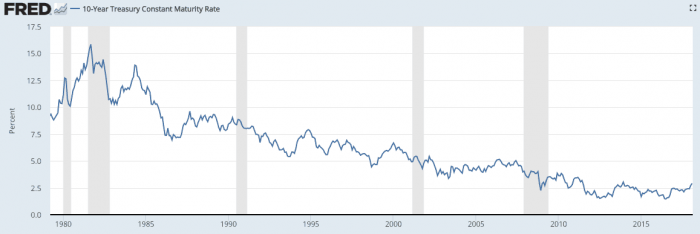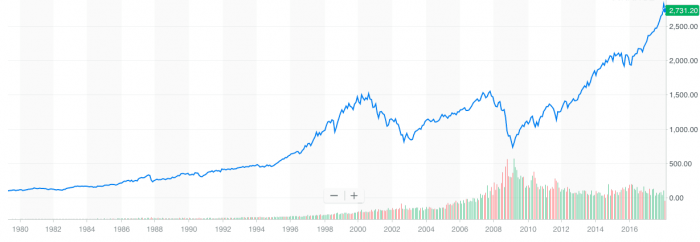A couple of weeks ago I mentioned Albert Edwards’ bullish views on US Treasuries. The interesting bit was his prediction that 10-year Treasury rates would exceed 3% before long. He is basically saying, ‘first the meltdown, then the melt-up’. That’s the exact opposite of Ray Dalio is saying about equities, by the way. So I thought I would highlight Edwards’ thinking given he has released an update.
Myth: Equities and Bonds move in opposite directions
You would think that Ray Dalio’s view goes hand in hand with Edwards’. After all, the common saying is that equities and bonds move in opposite directions. When bonds are up, equities are down and vice versa. But that’s not really true.
We’ve had the greatest bull market in bond market history since the early 1980s. Yields of nearly 16% plummeted to below 2% in the past decade.
At the same time, stocks have rallied, with the S&P500 up 27x in the same period.
So, for over three decades, stocks and bonds have been moving mostly in lockstep. In fact, one could argue that the fall in interest rates was a main buttress for equities.
And now, just because we are now nearly to 3%, everyone thinks the bond bull market is over.
Edwards on the meltdown in bonds…
Albert Edwards isn’t buying it. His view:
Although I agree with the bond bears that US yields will continue to rise, causing more problems for equities, I do not believe bond yields have yet seen a secular bottom. I repeat my forecast that US 10y yields will fall below zero.
That’s what he said two weeks ago as yields were climbing. And although “many see this as a great time to dump bonds and switch into equities”, Edwards’ doesn’t. And that’s because the meltdown in bonds will sow the seeds of a melt-up.
Think of the meltdown in bonds the way Former UBS economist George Magnus puts it:
Trillion dollar deficits are just over the horizon, which will cause US government debt as a share of GDP to rise in the next several years to over 100 per cent. While debt levels alone cannot predict what will happen to bond yields, the markets fear that significant unfunded government borrowing—especially when the economy is doing well—will cause the Federal Reserve to carry on raising interest rates, in turn pushing bond yields higher. On current trends, this cyclical shift will eventually, maybe in 2019, puncture the stock market, corporate profits, and most likely the economy.
The deficits themselves are not the worry. Nor is the inflation they could cause, if the economy turns out to be at full capacity. Look at the UK and rising inflation there. The inflation rate is 3%. Yet, British 10-year yields remain stuck at 1.6%. What gives? It’s the central bank, the Bank of England. They won’t move the way the Fed is expected to do. That’s why UK long-term rates are so low.
It’s the impact on the Fed’s reaction function that matters. Large new deficits will alarm the Fed and precipitate tightening. And this is especially true because the fiscal policy is pro-cyclical.
Bonds will then melt UP
But, then what?
Edwards:
Yet the outcome of this front-end loaded stimulus package is patently obvious. It will rapidly accelerate the end of the economic cycle.
He writes that in bold. That’s from his most recent commentary.
The Fed will tighten more aggressively. That’s the takeaway here. And they will be doing so at the most dangerous point in the economic cycle. This is when policy errors happen – when central banks over-tighten.
Market corrections like the one we just experienced lessen the chance of over-tightening. But now that the dust has settled, all is well. Equity markets continue higher and we are back to where we were two weeks ago. The key difference is 10-year interest rates are now 2.88%, instead of 2.68%.
Over the medium-term, the increase in rates will be a stimulant for people in the private sector starved of interest income. It won’t be the depressant the Fed wants it to be. Moreover, we could even see some debtors pull forward their borrowing to lock in lower borrowing rates. That would mean higher credit growth.
But eventually, the higher rates will catch up with debtors. And when it does, that is when this business cycle gets interesting.


Comments are closed.